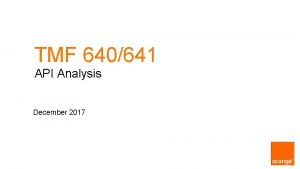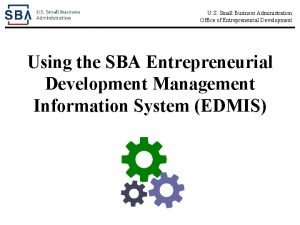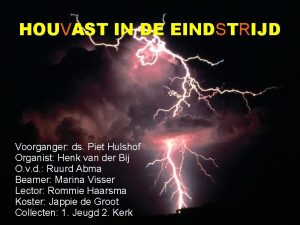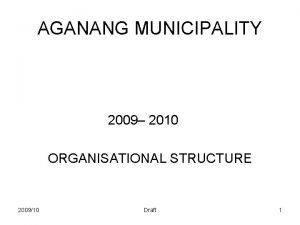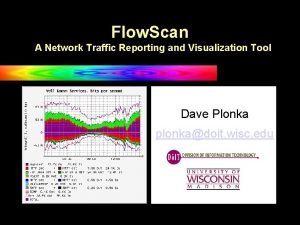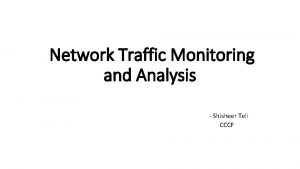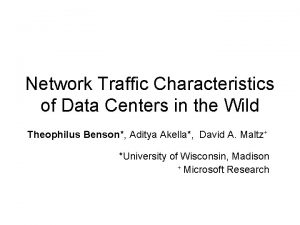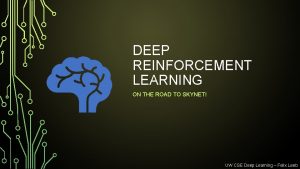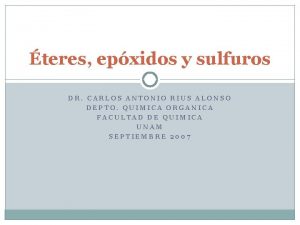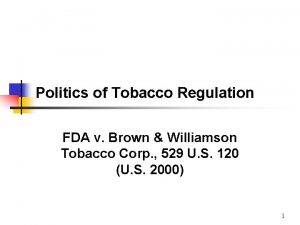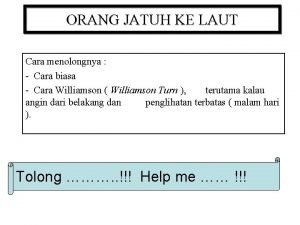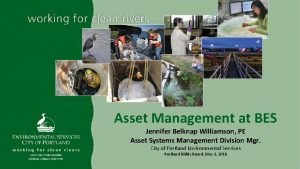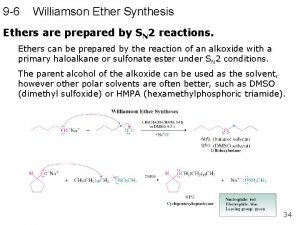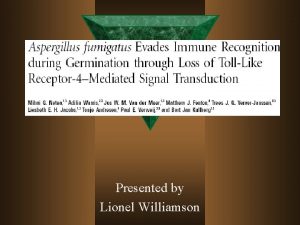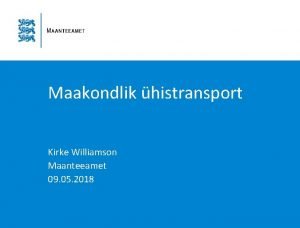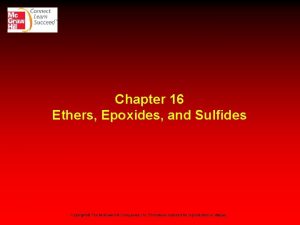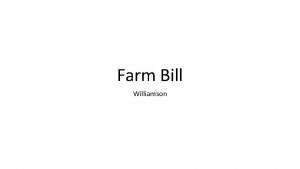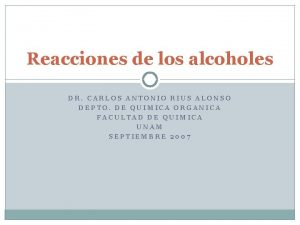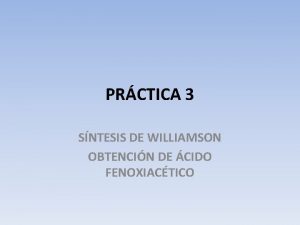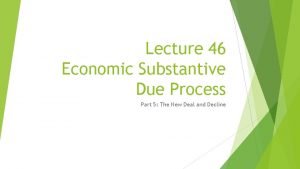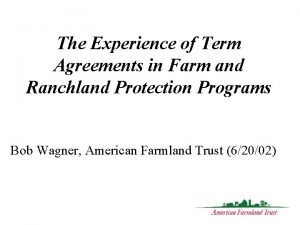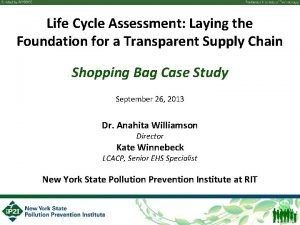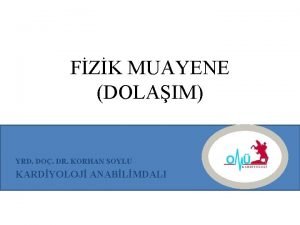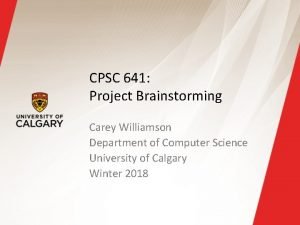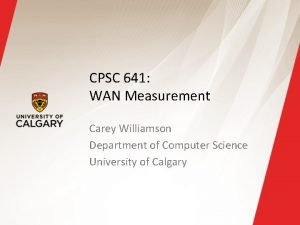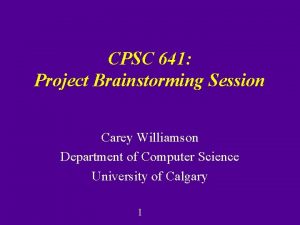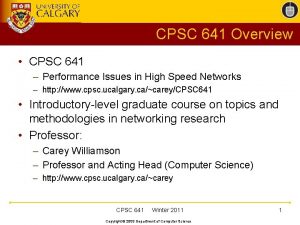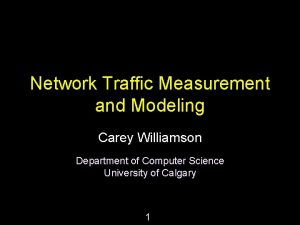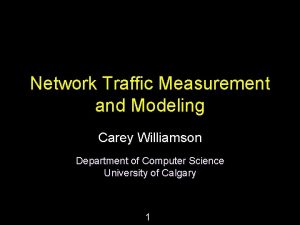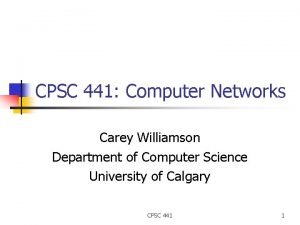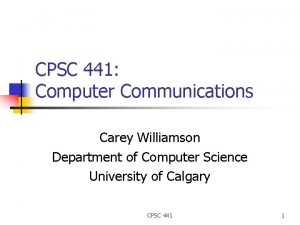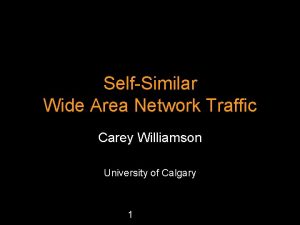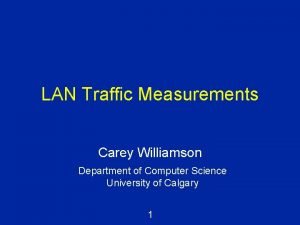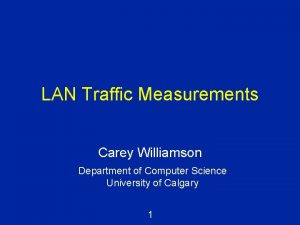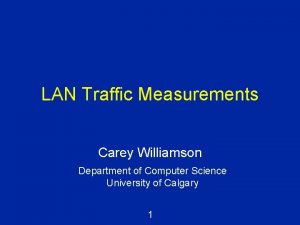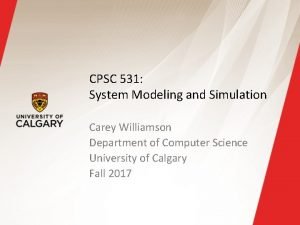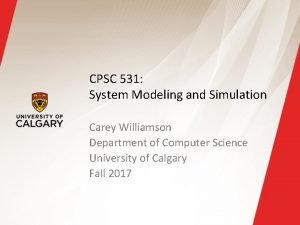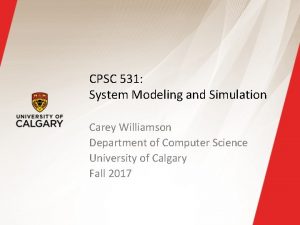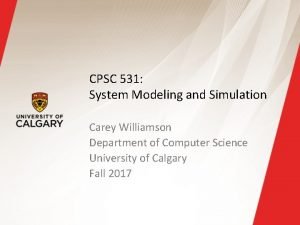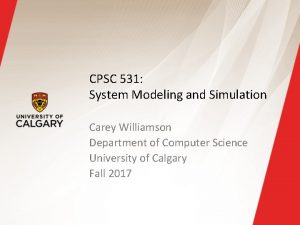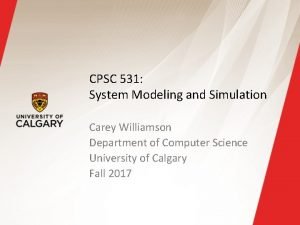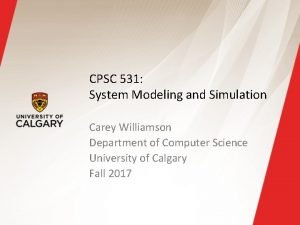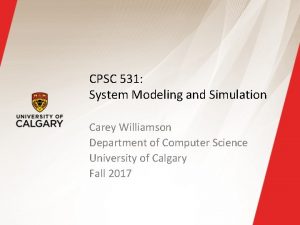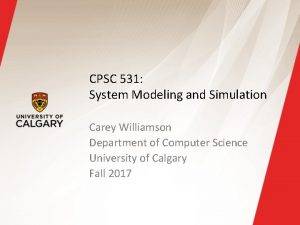CPSC 641 Network Traffic SelfSimilarity Carey Williamson Department





















































- Slides: 53

CPSC 641: Network Traffic Self-Similarity Carey Williamson Department of Computer Science University of Calgary

Introduction § A classic network traffic measurement study has shown that aggregate Ethernet LAN traffic is self-similar [Leland et al 1993] § A statistical property that is very different from the traditional Poisson-based models § This presentation: definition of network traffic selfsimilarity, Bellcore Ethernet LAN data, implications of self-similarity

Measurement Methodology § Collected lengthy traces of Ethernet LAN traffic on Ethernet LAN(s) at Bellcore § High resolution time stamps § Analyzed statistical properties of the resulting time series data § Each observation represents the number of packets (or bytes) observed per time interval (e. g. , 10 4 8 12 7 2 0 5 17 9 8 8 2. . . )

Self-Similarity: The Intuition § If you plot the number of packets observed per time interval as a function of time, then the plot looks ‘‘similar’’ regardless of what interval size you choose § E. g. , 10 msec, 100 msec, 10 sec, . . . § Same applies if you plot number of bytes observed per interval of time

Self-Similarity: The Intuition § In other words, self-similarity implies a ‘‘fractallike’’ behaviour: no matter what time scale you use to examine the data, you see similar patterns § Implications: — Burstiness exists across many time scales — No natural length of a burst — Traffic does not necessarilty get ‘‘smoother” when you aggregate it (unlike Poisson traffic)

Self-Similarity: The Mathematics § Self-similarity is a rigourous statistical property (i. e. , a lot more to it than just the pretty ‘‘fractallike’’ pictures) § Assumes you have time series data with finite mean and variance (i. e. , covariance stationary stochastic process) § Must be a very long time series (infinite is best!) § Can test for presence of self-similarity

Self-Similarity: The Mathematics § Self-similarity manifests itself in several equivalent fashions: § Slowly decaying variance § Long range dependence § Non-degenerate autocorrelations § Hurst effect

Slowly Decaying Variance § The variance of the sample decreases more slowly than the reciprocal of the sample size § For most processes, the variance of a sample diminishes quite rapidly as the sample size is increased, and stabilizes soon § For self-similar processes, the variance decreases very slowly, even when the sample size grows quite large

Variance-Time Plot § The ‘‘variance-time plot” is one method to test for the slowly decaying variance property § Plots the variance of the sample versus the sample size, on a log-log plot § For most processes, the result is a straight line with slope -1 § For self-similar, the line is much flatter

Variance-Time Plot m

Variance-Time Plot 100. 0 Variance 10. 0 Variance of sample on a logarithmic scale 0. 01 0. 0001 m

Variance-Time Plot Sample size m on a logarithmic scale 1 10 100 m 10 4 10 5 10 6 10 7

Variance-Time Plot m

Variance-Time Plot m

Variance-Time Plot Slope = -1 for most processes m

Variance-Time Plot m

Variance-Time Plot Slope flatter than -1 for self-similar process m

Long Range Dependence § Correlation is a statistical measure of the relationship, if any, between two random variables § Positive correlation: both behave similarly § Negative correlation: behave in opposite fashion § No correlation: behaviour of one is statistically unrelated to behaviour of other

Long Range Dependence (Cont’d) § Autocorrelation is a statistical measure of the relationship, if any, between a random variable and itself, at different time lags § Positive correlation: big observation usually followed by another big, or small by small § Negative correlation: big observation usually followed by small, or small by big § No correlation: observations unrelated

Long Range Dependence (Cont’d) § Autocorrelation coefficient can range between +1 (very high positive correlation) and -1 (very high negative correlation) § Zero means no correlation § Autocorrelation function shows the value of the autocorrelation coefficient for different time lags k

Autocorrelation Coefficient Autocorrelation Function +1 0 -1 0 lag k 100

Autocorrelation Coefficient Autocorrelation Function +1 Maximum possible positive correlation 0 -1 0 lag k 100

Autocorrelation Coefficient Autocorrelation Function +1 0 -1 Maximum possible negative correlation 0 lag k 100

Autocorrelation Coefficient Autocorrelation Function +1 No observed correlation at all 0 -1 0 lag k 100

Autocorrelation Coefficient Autocorrelation Function +1 0 -1 0 lag k 100

Autocorrelation Coefficient Autocorrelation Function +1 Significant positive correlation at short lags 0 -1 0 lag k 100

Autocorrelation Coefficient Autocorrelation Function +1 0 No statistically significant correlation beyond this lag -1 0 lag k 100

Long Range Dependence (Cont’d) § For most processes (e. g. , Poisson, or compound Poisson), the autocorrelation function drops to zero very quickly (usually immediately, or exponentially fast) § For self-similar processes, the autocorrelation function drops very slowly (i. e. , hyperbolically) toward zero, but may never reach zero § Non-summable autocorrelation function

Autocorrelation Coefficient Autocorrelation Function +1 Typical long-range dependent process 0 Typical short-range dependent process -1 0 lag k 100

Non-Degenerate Autocorrelations § For self-similar processes, the autocorrelation function for the aggregated process is indistinguishable from that of the original process § If autocorrelation coefficients match for all lags k, then called exactly self-similar § If autocorrelation coefficients match only for large lags k, then called asymptotically self-similar

Autocorrelation Coefficient Autocorrelation Function +1 Original self-similar process 0 Aggregated self-similar process -1 0 lag k 100

Aggregation § Aggregation of a time series X(t) means smoothing the time series by averaging the observations over non-overlapping blocks of size m to get a new time series X (t) m

Aggregation: An Example § Suppose the original time series X(t) contains the following (made up) values: 2 7 4 12 5 0 8 2 8 4 6 9 11 3 3 5 7 2 9 1. . . § Then the aggregated series for m = 2 is:

Aggregation: An Example § Suppose the original time series X(t) contains the following (made up) values: 2 7 4 12 5 0 8 2 8 4 6 9 11 3 3 5 7 2 9 1. . . § Then the aggregated series for m = 2 is: 4. 5 8. 0 2. 5 5. 0 6. 0 7. 5 7. 0 4. 5 5. 0. . .

Aggregation: An Example § Suppose the original time series X(t) contains the following (made up) values: 2 7 4 12 5 0 8 2 8 4 6 9 11 3 3 5 7 2 9 1. . . Then the aggregated time series for m = 5 is:

Aggregation: An Example § Suppose the original time series X(t) contains the following (made up) values: 2 7 4 12 5 0 8 2 8 4 6 9 11 3 3 5 7 2 9 1. . . Then the aggregated time series for m = 5 is: 6. 0 4. 4 6. 4 4. 8. . .

Autocorrelation Coefficient Autocorrelation Function +1 Original self-similar process 0 Aggregated self-similar process -1 0 lag k 100

The Hurst Effect § For almost all naturally occurring time series, the rescaled adjusted range statistic (also called the R/S statistic) for sample size n obeys the relationship H E[R(n)/S(n)] = c n where: R(n) = max(0, W 1, . . . Wn) - min(0, W 1, . . . Wn) S(n) is the sample standard deviation, and k Wk = X i - k Xn for k = 1, 2, . . . n i =1

The Hurst Effect (Cont’d) § For models with only short range dependence, H is almost always 0. 5 § For self-similar processes, 0. 5 < H < 1. 0 § This discrepancy is called the Hurst Effect, and H is called the Hurst parameter § Single parameter to characterize self-similar process!

R/S Statistic: An Example § Suppose the original time series X(t) contains the following (made up) values: 2 7 4 12 5 0 8 2 8 4 6 9 11 3 3 5 7 2 9 1 § There are 20 data points in this example

R/S Statistic: An Example § Suppose the original time series X(t) contains the following (made up) values: 2 7 4 12 5 0 8 2 8 4 6 9 11 3 3 5 7 2 9 1 § There are 20 data points in this example § For R/S analysis with n = 1, you get 20 samples, each of size 1: (boring base case) Block 1: X = 2, W 1= 0, R(n) = 0, S(n) = 0 Block 2: X = 7, W 1= 0, R(n) = 0, S(n) = 0 Block 3: X = 4, W 1= 0, R(n) = 0, S(n) = 0

R/S Statistic: An Example § Suppose the original time series X(t) contains the following (made up) values: 2 7 4 12 5 0 8 2 8 4 6 9 11 3 3 5 7 2 9 1 § For R/S analysis with n = 2, you get 10 samples, each of size 2:

R/S Statistic: An Example § Suppose the original time series X(t) contains the following (made up) values: 2 7 4 12 5 0 8 2 8 4 6 9 11 3 3 5 7 2 9 1 § For R/S analysis with n = 2, you get 10 samples, each of size 2: Block 1: Xn = 4. 5, W 1 = -2. 5, W 2 = 0, R(n) = 0 - (-2. 5) = 2. 5, S(n) = 2. 5, R(n)/S(n) = 1. 0

R/S Statistic: An Example § Suppose the original time series X(t) contains the following (made up) values: 2 7 4 12 5 0 8 2 8 4 6 9 11 3 3 5 7 2 9 1 § For R/S analysis with n = 2, you get 10 samples, each of size 2: Block 2: Xn = 8. 0, W 1 = -4. 0, W 2 = 0, R(n) = 0 - (-4. 0) = 4. 0, S(n) = 4. 0, R(n)/S(n) = 1. 0

R/S Statistic: An Example § Suppose the original time series X(t) contains the following (made up) values: 2 7 4 12 5 0 8 2 8 4 6 9 11 3 3 5 7 2 9 1 § For R/S analysis with n = 5, you get 4 samples, each of size 5:

R/S Statistic: An Example § Suppose the original time series X(t) contains the following (made up) values: 2 7 4 12 5 0 8 2 8 4 6 9 11 3 3 5 7 2 9 1 § For R/S analysis with n = 5, you get 4 samples, each of size 4: Block 1: Xn = 6. 0, W 1 = -4. 0, W 2 = -3. 0, W 3 = -5. 0 , W 4 = 1. 0 , W 5 = 0, S(n) = 3. 41, R(n) = 1. 0 - (-5. 0) = 6. 0, R(n)/S(n) = 1. 76

R/S Statistic: An Example § Suppose the original time series X(t) contains the following (made up) values: 2 7 4 12 5 0 8 2 8 4 6 9 11 3 3 5 7 2 9 1 § For R/S analysis with n = 5, you get 4 samples, each of size 4: Block 2: X n= 4. 4, W 1 = -4. 4, W 2 = -0. 8, W 3 = -3. 2 , W 4 = 0. 4 , W 5 = 0, S(n) = 3. 2, R(n) = 0. 4 - (-4. 4) = 4. 8, R(n)/S(n) = 1. 5

R/S Plot § Another way of testing for self-similarity, and estimating the Hurst parameter § Plot the R/S statistic for different values of n, with a log scale on each axis § If time series is self-similar, the resulting plot will have a straight line shape with a slope H that is greater than 0. 5 § Called an R/S plot, or R/S pox diagram

R/S Statistic R/S Pox Diagram Block Size n

R/S Statistic R/S Pox Diagram R/S statistic R(n)/S(n) on a logarithmic scale Block Size n

R/S Statistic R/S Pox Diagram Sample size n on a logarithmic scale Block Size n

R/S Statistic R/S Pox Diagram Slope 1. 0 Slope H (0. 5 < H < 1. 0) (Hurst parameter) Slope 0. 5 Block Size n

Summary § Self-similarity is an important mathematical property that has been identified as present in network traffic measurements § Important property: burstiness across many time scales, traffic does not aggregate well § There exist several mathematical methods to test for the presence of self-similarity, and to estimate the Hurst parameter H § There exist models for self-similar traffic
 Guilherme carey ou william carey
Guilherme carey ou william carey Amy williamson iowa department of education
Amy williamson iowa department of education Tmf 640 vs tmf 641
Tmf 640 vs tmf 641 Sba form 641
Sba form 641 Lied 641 jezus leeft en ik met hem
Lied 641 jezus leeft en ik met hem Tmf 638
Tmf 638 641 x 3
641 x 3 Inbound traffic vs outbound traffic
Inbound traffic vs outbound traffic All traffic solutions traffic cloud
All traffic solutions traffic cloud Aganang traffic department
Aganang traffic department Network traffic flow diagram
Network traffic flow diagram Network traffic management techniques
Network traffic management techniques Network traffic monitoring techniques
Network traffic monitoring techniques Understanding data center traffic characteristics
Understanding data center traffic characteristics Network traffic recorder
Network traffic recorder Network traffic alpha sky net
Network traffic alpha sky net Traffic engineering network
Traffic engineering network Bethan williamson
Bethan williamson Williamson sentezi
Williamson sentezi Sintesis de williamson eteres
Sintesis de williamson eteres Micah williamson
Micah williamson Fda vs brown and williamson
Fda vs brown and williamson Metode williamson turn
Metode williamson turn Historic iris identification
Historic iris identification Tetraidropirano
Tetraidropirano Bloody williamson
Bloody williamson Jennifer belknap
Jennifer belknap Ether synthesis
Ether synthesis Dr emma williamson
Dr emma williamson Lionel williamson
Lionel williamson Kirke williamson
Kirke williamson Andrea hardcastle ron williamson
Andrea hardcastle ron williamson Super archway model
Super archway model Vanderbilt nurse residency interview questions
Vanderbilt nurse residency interview questions Eg williamson trait and factor theory
Eg williamson trait and factor theory In williamson’s synthesis, ethoxyethane is prepared by-
In williamson’s synthesis, ethoxyethane is prepared by- Billy williamson state farm
Billy williamson state farm Rosecrance griffin williamson campus
Rosecrance griffin williamson campus Esterificación
Esterificación Sintesis de williamson
Sintesis de williamson Williamson v. lee optical
Williamson v. lee optical Williamson act pros and cons
Williamson act pros and cons Circle of knowing
Circle of knowing Nikki williamson
Nikki williamson Anahita williamson
Anahita williamson Kewirausahaan adalah
Kewirausahaan adalah Nikki williamson
Nikki williamson Addie carey
Addie carey Lonnie franklin
Lonnie franklin Reverend william carey
Reverend william carey Ms carey ap psych
Ms carey ap psych Juguler ven pulsasyonu
Juguler ven pulsasyonu Dick and carey model
Dick and carey model Ipisd
Ipisd


